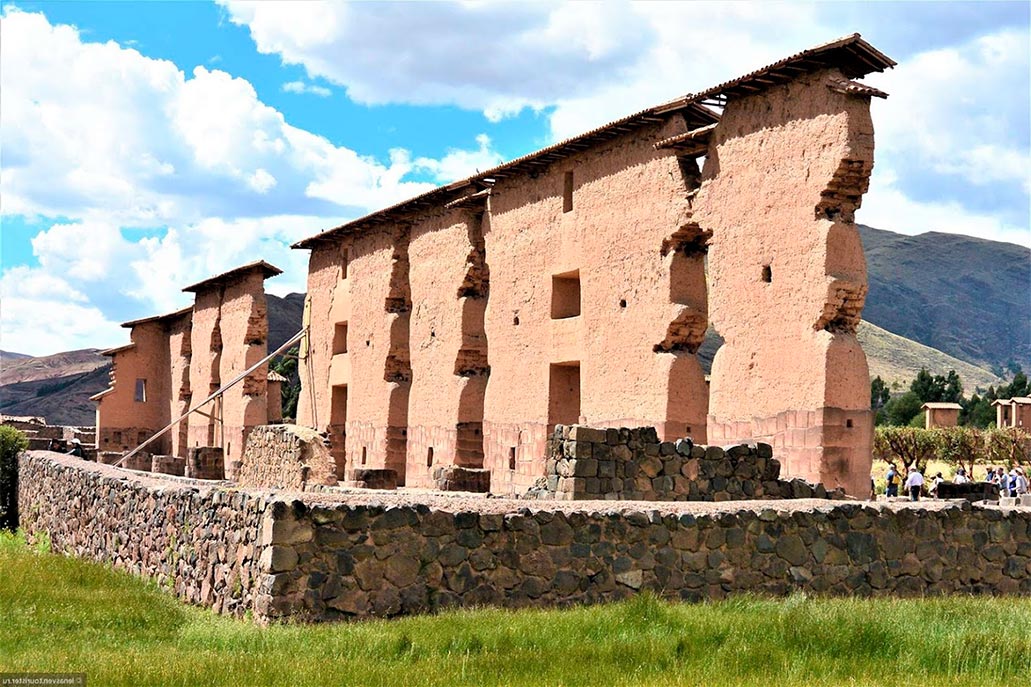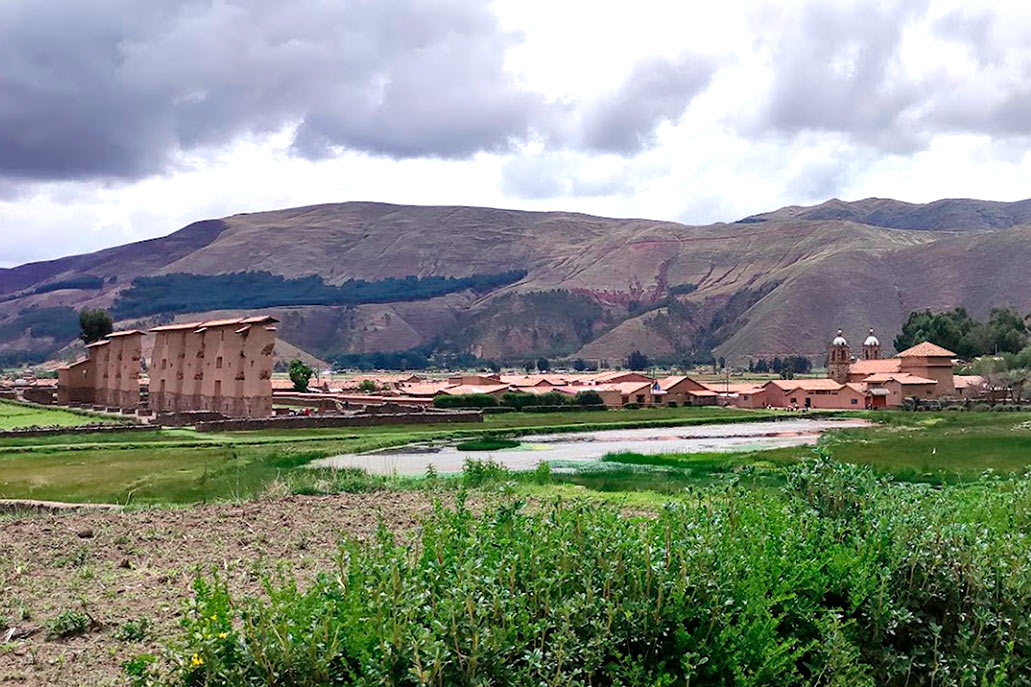Cusco – Raqchi: a special trip to the temple of Wiracocha
Raqchi is located south of Cusco. This destination never ceases to amaze due to the discoveries made in recent years. There are different tours to get to the largest temple of worship to the god Wiracocha. In addition to presenting different archaeological remains that discover it as an important point, in the network of Inca roads or the Qhapaq Ñam.
Contents
1. Raqchi, an important point in the Qhapac Ñam
Raqchi or “Cacha”, name used by the Incas to describe this area of Tawantisuyo, is located on the slopes of a small extinct volcano, Kinsach’ata, and on the banks of the imposing river Vilcanota. Precisely 110 kilometers in the south valley of Cusco, in the district of San Pedro in the province of Canchis. Its greatest attraction are the remains of a 12-meter-high wall that was part of the Wiracocha temple. This wall has a polygonal style at the base and fine finishes at the top, which is made of adobe. This wall supported the roof of a construction approximately 92 meters long.
This temple was dedicated to the god Wiracocha. It is estimated, according to chronicles, that the construction period spanned almost a century. Some research shows that the insertion of the Inca culture can only be seen in some parts of the place. Therefore, it is estimated that Raqchi represented a place that resisted the total domination of the Empire, but enjoyed its protection as it was considered a sacred place.
The Raqchi enclosure can be understood as a place that was in the process of being aligned with the Tawantinsuyo or as an exclusive place to perform rituals. It should be seen as a ceremonial point very similar to those found in Pachacamaq and Isla del Sol, centers that the Incas conquered and that were rebuilt little by little, but of great religious importance.
This archaeological site is of great importance for the economic and social development of Tawantinsuyo. At present, it continues to represent a mystery due to the different remains found. Excavations and investigations continue. Raqchi is also famous for the folk festival in June and for the presence of the imposing temple that was erected on the main plain of the enclosure.
2. The archaeological complex of Raqchi
This entire archaeological complex has a land area of almost a thousand hectares. Throughout this territory you can find different constructions. Let’s start from the most important and of great value. The most important is the temple to Wiracocha, the colcas or warehouses, some houses for the chasquis and the fountains or water baths. In addition to an artificial lagoon, a viewpoint from the Kinsacha’ta volcano and you can also see a section of the Qhapac Ñan route.
a) The temple of Lord
It is the main attraction and one of the highest constructions that can be found in the Inca empire. This temple was in the form of a kallanka. That is, an Inca architecture design that is based on having a rectangular shape with a thatched roof with two waterfalls. This structure was 25 meters wide, 92 meters long, it is estimated that the height could reach 12 meters.
Another important factor of the structure of this construction, are the columns positioned on the flanks of the wall, so far they can be appreciated. These columns had a stone base carved in the shape of a ‘cushion’ characteristic of Inca architecture after 1450 AD These stone bases reached three meters in height with a diameter of 1.6 meters, then they proceeded to complete it with adobe , at a height of eight meters and relative to the central wall to serve as a support.
This characteristic temple of Raqchi served as the main worship center for the god Wiracocha. This god is not exclusive to the Incas. According to research, the first worships date from the Caral culture (3000 BC to 1800 BC), in other cultures that were found were in Chavín (1200 BC to 400 BC), Paracas (700 BC to 200 AD), Tiahuanaco (1500 BC to 1187 AD) and Wari (100 AD to 1200 AD). Most of the cultures that worship him attribute the creation of the universe to him. Although the Incas worshiped him, for them, the most worshiped god was the Sun.
b) Receiving or Receiving Barracks
It is estimated that the enclosures found in the area behind the temple were houses for residents and also for visitors, messengers or commissions to transport food. In the archaeological remains of Raqchi, there are 22 houses built in an organized way. Twelve houses are lined up in pairs along 250 meters.
The remaining buildings are distributed around square patios, but only on three sides. These patios are known as pukllapampa or “playground”. These dwellings have niches and carved walls. They are Inca constructions very similar to the temple wall.
c) Warehouses or Colcas
The warehouses are distributed at one end of the entire territory. They are perfectly organized in the form of a row, it is estimated that there are more than 150 colcas. They are separated from the houses by cultivated fields. Where corn was surely grown.
The shape of these constructions is circular with a stone base and thatched roofs. These warehouses were intended to preserve and store different foods.
d) Inca Baths
These are finely carved stone constructions, which show the beauty of the continuous flow of water. Their shape is rectangular. They served to supply water to the population. Different types can be found, the best carved, it is estimated they were for the use of bathrooms and the others as water sources. Unfortunately, some are no longer in good condition.
e) Artificial lagoon
This small lagoon served to increase the beauty of the place. The location of this lagoon with the location of the temple, have symmetry in the direction of the Kinsach’ata volcano. It is possible that the presence of water and the volcano were used as a representation of a pacarina or place of origin of the Canas settlers, inhabitants of ancient Raqchi, as the legend of Wiracocha narrates.
f) Qhapaq Ñam
It is the most important road network of the Inca culture. The presence of the colcas in the archaeological site of Raqchi demonstrates the great importance that this place had in relation to the rest of the dairy farms or communities, distributed along the Tawantinsuyo. In recent excavations, remains of ceramics and utensils from different eras and non-Inca cultures were found. This leads researchers to think that the chiefs or curacas of the place put up resistance in terms of adaptation or cultural alignment, but they followed the Inca regime.
3. Cusco – Raqchi: How to get there?
Unfortunately, there is not a wide variety of tours that visit Raqchi. However, it can be done by making reservations in advance or through a private tour with a tourism agency. The main options, departing from Cusco are:
Pikillaqta – Andahuaylillas – Raqchi
This day tour, contemplates trips outside the city of Cusco. The tour starts by visiting the archaeological center of Pikillaqta. Then, continue the journey to the district of Andahuaylillas to visit its church of Baroque architecture and finishes. Finally visit the community of Raqchi and enter this enclosure.
This tour includes lunch, tour guide and admission to the mentioned sites. The transportation included is round trip. The price is 80 US dollars.
Cusco – Raqchi – Pukara
It is a longer tour, but quite similar to the previous one. It begins with the departure from Cusco in the direction of the Andahuaylillas church, passing through Raqchi to finish the journey in Pukara, where archaeological remains and a museum will be visited. This last place belongs to the Puno region. The price is from 65 American dollars.
Experiential tourism in Raqchi
This service is a cultural option for those who wish to spend a night near the archaeological site of Raqchi. In this tourism, you will have contact with the people of Raqchi, who inherited a thousand-year-old tradition and keep a large part of that culture intact. It has accommodation for one night and food.
This tour offers a guided visit to the Wiracocha temple and the community’s viewpoint, a walk through the Qhapac Ñan, a visit to the volcano, a demonstration pottery workshop. When the night begins, an offering is made to the Apus and Pachamama, then a dancing campfire is made. The price is from 80 US dollars.
Visit Raqchi by own account
If you want to visit Raqchi from Cusco independently, it is possible. The first thing you have to do is go to the Cusco – Sicuani bus terminal, this terminal is located on Calle Huayruropata. After that, all you have to do is tell the bus driver that you are staying in Raqchi. The trip is approximately two and a half hours. Once in the place, you will have to buy the entrance ticket that costs approximately 10 soles or 3 American dollars.
4. Recommendations
Visiting the archaeological site of Raqchi does not require much effort nor does it imply great difficulty. However, due to the climate in the area, it is always recommended to wear a sun hat or cap, along with sunscreen. A windbreaker jacket and light clothing. It will not hurt to wear comfortable shoes and a waterproof poncho, in case it rains.
5. Frequently asked questions
What is Rack?
Raqchi is an archaeological complex, which is estimated to have served as a meeting point for the Colcas or warehouses that were found. It housed one of the largest temples of the Inca culture in worship of the god Wiracocha.
Where is it?
Raqchi is located in the San Pedro district in the Canchis province of the Cusco region. The bus trip is approximately two and a half hours.
What altitude is Raqchi?
It is at an altitude of 3,550 meters above sea level
How’s the weather?
The weather in the months of April to October is quite dry. However, the remains of months can rain. It is a place with a cold and dry climate. In the mornings the temperature is up to 18° C., while at night it can drop to 0° C.
When to go?
It is recommended to go in any month of the year. The archaeological site of Raqchi is easily accessible. In case of rain, a poncho would be enough, until seeking refuge in the community, which is quite close.
How to go?
There are two tours that can take you to Raqchi and there is also the option of experiential tourism for 2 days and one night. Prices start from 65 US dollars.
How much does it cost to go to Raqchi?
Tour prices start at US$65.
Is it possible to go to Raqchi without a tour agency?
Yes, all you have to do is take a Cusco – Sicuani bus. The enclosure is very close to the paved road.
How much is the ticket to Raqchi?
The entrance fee per person is 10 soles or 3 US dollars.
Is it easy to get there?
Yes, access to Raqchi does not require long walks.
By Imachupicchu – Last updated, August 22, 2024


